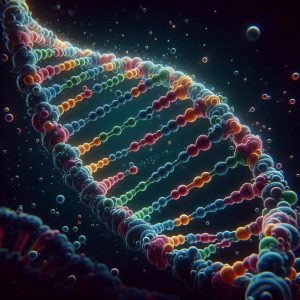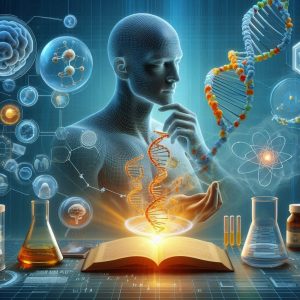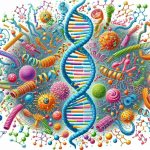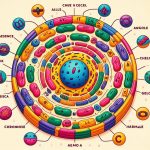DNA: The Blueprint of Life
DNA, or deoxyribonucleic acid, is the molecule that carries the genetic instructions used in the growth, development, functioning, and reproduction of all known living organisms and many viruses. It is the hereditary material in humans and almost all other organisms.

Structure of DNA
DNA is composed of two long strands that coil around each other to form a double helix. Each strand is made up of simpler molecules called nucleotides. Each nucleotide contains a phosphate group, a sugar group, and a nitrogen base. The four types of nitrogen bases are adenine (A), thymine (T), guanine (G), and cytosine (C).

DNA (deoxyribonucleic acid) has a unique and highly organized structure that is essential for its function as the blueprint of life. The structure of DNA can be described in several key components, including its double helix formation, nucleotide composition, and the arrangement of its strands.
Double Helix Formation
DNA is famously known for its double helix structure, which was first described by James Watson and Francis Crick in 1953. The double helix is composed of two long strands that coil around each other, forming a helical shape. This structure is stabilized by hydrogen bonds between the nitrogenous bases and the interactions between the sugar-phosphate backbones of the strands.
Nucleotide Composition
The fundamental units of DNA are nucleotides, which consist of three components:
- Phosphate Group: A molecule that forms the backbone of the DNA strand, linking sugars and providing stability to the DNA structure.
- Sugar (Deoxyribose): A five-carbon sugar molecule that forms part of the backbone of the DNA strand, alternating with phosphate groups.
- Nitrogenous Bases: The four bases in DNA are adenine (A), thymine (T), guanine (G), and cytosine (C). These bases pair specifically with each other, with adenine pairing with thymine and guanine pairing with cytosine.
Base Pairing and Helical Twist
In the DNA double helix, the nitrogenous bases from one strand form hydrogen bonds with the bases on the opposite strand. This base pairing is highly specific: adenine pairs with thymine through two hydrogen bonds, and guanine pairs with cytosine through three hydrogen bonds. This particular pairing is crucial for accurate DNA replication and maintaining the integrity of genetic information.
The helical twist of the DNA molecule allows it to fit within the confines of the cell nucleus. The double helix has a right-handed twist, which means it spirals clockwise as it extends from the base pairs.
Antiparallel Strands
The two strands of DNA run in opposite directions, which is referred to as antiparallel orientation. One strand runs in the 5′ to 3′ direction, while the other runs in the 3′ to 5′ direction. This antiparallel arrangement is essential for the processes of DNA replication and transcription, as it ensures that the enzymes involved can work effectively on the DNA.
| Component | Description |
|---|---|
| Double Helix | The twisted ladder-like structure of DNA, consisting of two intertwined strands. |
| Nucleotide | DNA’s building block comprises a phosphate group, a deoxyribose sugar, and a nitrogenous base. |
| Base Pairing | Specific pairing between adenine, thymine, and guanine and cytosine are held together by hydrogen bonds. |
| Antiparallel Strands | The orientation of DNA strands running in opposite directions, critical for replication and transcription. |
Function of DNA
DNA (deoxyribonucleic acid) is fundamental to the biology of all living organisms. Its primary functions revolve around storing genetic information, guiding cellular processes, and ensuring the accurate transmission of genetic traits across generations. Here’s an in-depth look at the key functions of DNA.
1. Storage of Genetic Information
DNA functions as the blueprint for all living organisms. It contains the genetic instructions used in organisms’ development, functioning, growth, and reproduction. The sequence of nucleotides in DNA encodes the genetic information required to build and maintain an organism. This genetic code is organized into genes, which are segments of DNA that carry instructions for specific traits and functions.
2. Genetic Code and Protein Synthesis
The genetic code in DNA is transcribed into RNA (ribonucleic acid) in a process called transcription. This RNA is then translated into proteins in a process called translation. Proteins are crucial molecules that perform a variety of functions in the cell, including acting as enzymes, structural components, and signaling molecules. The sequence of nucleotides in DNA determines the sequence of amino acids in a protein, which in turn determines the protein’s function and structure.
3. Replication and Cell Division
DNA replication is a critical process that occurs before cell division. During replication, the DNA molecule is copied to ensure that each new cell receives an identical set of genetic instructions. This process involves unwinding the double helix, synthesizing new strands complementary to the original strands, and then reassembling the double helix. Accurate DNA replication is essential for maintaining genetic stability and preventing mutations.
4. Mutation and Genetic Variation
Mutations are changes in the DNA sequence that can lead to genetic variation. While some mutations can be harmful or lead to genetic disorders, others can be beneficial and contribute to the evolution of species. DNA’s ability to mutate and generate genetic diversity is crucial for adaptation and evolution, enabling organisms to survive in changing environments.
5. Regulation of Gene Expression
DNA also plays a role in regulating gene expression. Not all genes are active at all times; gene expression is controlled through various mechanisms that can activate or repress specific genes. This regulation allows cells to respond to environmental changes, differentiate into various cell types, and perform specialized functions.
| Function | Description |
|---|---|
| Storage of Genetic Information | DNA encodes the genetic blueprint for the development, functioning, and reproduction of organisms. |
| Genetic Code and Protein Synthesis | DNA’s sequence is transcribed into RNA, which is then translated into proteins that perform various functions in the cell. |
| Replication and Cell Division | DNA is replicated to ensure that each new cell receives an identical set of genetic instructions during cell division. |
| Mutation and Genetic Variation | Mutations in DNA generate genetic variation, which can be beneficial for adaptation and evolution. |
| Regulation of Gene Expression | DNA regulates gene expression to control which genes are active and how they respond to environmental changes. |
| Component | Description |
|---|---|
| Nucleotide | The basic unit of DNA, consisting of a phosphate group, a sugar group, and a nitrogen base. |
| Double Helix | The structure formed by two strands of DNA wound around each other. |
| Base Pairing | The pairing of adenine with thymine and guanine with cytosine, which holds the two strands of DNA together. |
DNA: The Blueprint of Life
DNA, or deoxyribonucleic acid, is the molecule that carries the genetic instructions used in the growth, development, functioning, and reproduction of all known living organisms and many viruses. It is the hereditary material in humans and almost all other organisms.
Structure of DNA
DNA is composed of two long strands that coil around each other to form a double helix. Each strand is made up of simpler molecules called nucleotides. Each nucleotide contains a phosphate group, a sugar group, and a nitrogen base. The four types of nitrogen bases are adenine (A), thymine (T), guanine (G), and cytosine (C).
Function of DNA
DNA stores genetic information that determines an organism’s traits and biological functions. It is responsible for guiding the processes that build and maintain the organism. The sequence of the nitrogen bases (A, T, G, C) in DNA encodes the instructions for building proteins, which are crucial molecules for many cellular functions.
| Component | Description |
|---|---|
| Nucleotide | The basic unit of DNA, consisting of a phosphate group, a sugar group, and a nitrogen base. |
| Double Helix | The structure formed by two strands of DNA wound around each other. |
| Base Pairing | The pairing of adenine with thymine and guanine with cytosine, which holds the two strands of DNA together. |
DNA Replication
DNA replication is a fundamental biological process that ensures the accurate copying of genetic material during cell division. This process is critical for the maintenance of genetic stability and for the proper functioning of living organisms. Here’s an overview of DNA replication, including its stages, mechanisms, and significance.
1. Overview of DNA Replication
DNA replication is the process by which a cell duplicates its DNA, resulting in two identical copies of the genetic material. This ensures that each daughter cell receives an exact copy of the parent cell’s DNA. DNA replication occurs in the S-phase of the cell cycle and involves a complex interplay of enzymes and other proteins.
2. Stages of DNA Replication
DNA replication is a multi-step process that involves several key stages:
- Initiation: Replication begins at specific locations on the DNA molecule called origins of replication. Proteins bind to these sites to unwind the DNA and separate the two strands, creating a replication bubble.
- Elongation: DNA polymerases add new nucleotide bases to the growing DNA strand, using the original strand as a template. This process proceeds in both directions from the origin, resulting in two new strands that are complementary to the original strands.
- Termination: Replication ends when the entire DNA molecule has been copied. The newly synthesized DNA strands are then checked for errors, and any necessary corrections are made.
3. Key Enzymes and Proteins
Several enzymes and proteins play crucial roles in DNA replication:
- DNA Helicase: Unwinds the double-stranded DNA.
- DNA Polymerase: Synthesizes new DNA strands by adding nucleotides complementary to the template strand.
- Primase: Synthesizes RNA primers, which provide a starting point for DNA polymerase.
- Ligase: Joins Okazaki fragments on the lagging strand to create a continuous DNA strand.
- Single-Strand Binding Proteins (SSBs): Stabilize the single-stranded DNA and prevent it from re-annealing.
4. Accuracy and Proofreading
DNA replication is a highly accurate process, but errors can occasionally occur. DNA polymerases have proofreading capabilities that allow them to correct errors during replication. Additionally, post-replication repair mechanisms further ensure the accuracy of the genetic material.
5. Clinical Relevance
Understanding DNA replication is essential for medical research and treatment. Defects in DNA replication can lead to various genetic disorders, cancers, and other diseases. Research into DNA replication mechanisms continues to provide insights into these conditions and potential therapeutic approaches.
| Stage | Description |
|---|---|
| Initiation | DNA unwinds and separates into two strands; replication bubbles form. |
| Elongation | New DNA strands are synthesized using the original strands as templates. |
| Termination | Replication ends and newly synthesized DNA strands are checked and corrected. |
FAQs
- 1. What is DNA?
- DNA (Deoxyribonucleic Acid) is a molecule that contains the genetic instructions used in the growth, development, functioning, and reproduction of all known organisms and many viruses. It carries genetic information in cells.
- 2. How is DNA structured?
- DNA has a double-helix structure consisting of two long strands that coil around each other. Each strand is composed of a backbone of sugar and phosphate groups, with nitrogenous bases (adenine, thymine, cytosine, and guanine) forming the rungs of the helix.
- 3. What is the role of DNA in replication?
- During DNA replication, the DNA molecule unwinds and separates into two strands. Each strand serves as a template for the creation of a new complementary strand, resulting in two identical DNA molecules from the original one.
- 4. Why is DNA replication important?
- DNA replication is crucial for cell division, ensuring that each new cell has an accurate copy of the genetic material. This process is vital for growth, repair, and reproduction in living organisms.
- 5. What can go wrong during DNA replication?
- Errors during DNA replication can lead to mutations, which may cause genetic disorders or contribute to the development of diseases such as cancer. The cell has mechanisms to repair such errors, but some may escape correction.
Disclaimers
1. Educational Purposes Only: The information provided in this article is for educational purposes only and is intended to offer a general understanding of DNA and its processes. It is not a substitute for professional medical or scientific advice.
2. Accuracy of Information: While we strive to ensure the accuracy of the information presented, the field of genetics is continually evolving. New research and discoveries may change our understanding of DNA and its functions.
3. No Medical Advice: This article does not provide medical advice, diagnosis, or treatment. Consult with a healthcare professional for advice on specific medical conditions or concerns related to genetic health.
Cautions
1. Handling Genetic Material: If you are involved in laboratory work, always follow proper safety protocols when handling DNA or other genetic materials to avoid contamination or exposure to hazardous substances.
2. Interpretation of Genetic Information: Genetic information and results should be interpreted by qualified professionals. Misinterpretation of genetic data can lead to incorrect conclusions or inappropriate actions.
3. Privacy Concerns: Genetic information is highly personal and sensitive. Be mindful of privacy and confidentiality when handling or sharing genetic data.
Related Links
- National Human Genome Research Institute – DNA
- Nature – DNA
- Encyclopaedia Britannica – DNA
- ScienceDaily – DNA
- National Human Genome Research Institute – DNA Replication
- NCBI – DNA Replication Mechanisms
- Encyclopaedia Britannica – DNA Replication
- Khan Academy – DNA Replication



